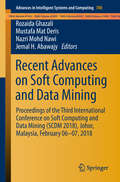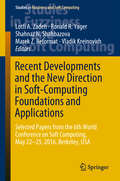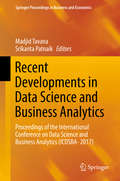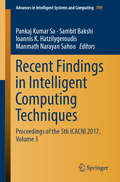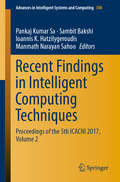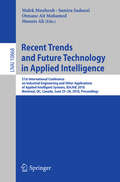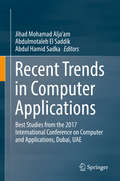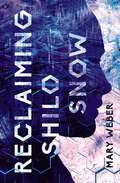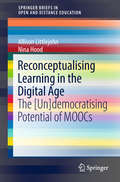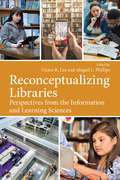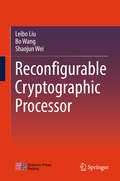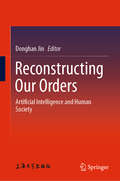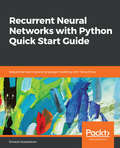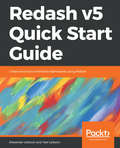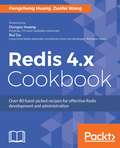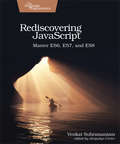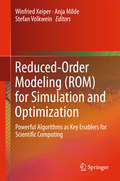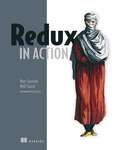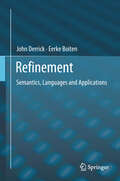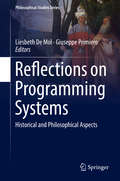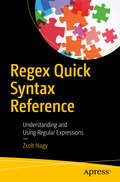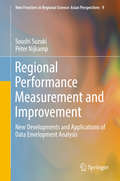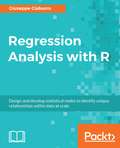- Table View
- List View
Recent Advances on Soft Computing and Data Mining
by Rozaida Ghazali Mustafa Mat Deris Nazri Mohd Nawi Jemal H. AbawajyThis book offers a systematic overview of the concepts and practical techniques that readers need to get the most out of their large-scale data mining projects and research studies. It guides them through the data-analytical thinking essential to extract useful information and obtain commercial value from the data. Presenting the outcomes of International Conference on Soft Computing and Data Mining (SCDM-2017), held in Johor, Malaysia on February 6-8, 2018, it provides a well-balanced integration of soft computing and data mining techniques. The two constituents are brought together in various combinations of applications and practices. To thrive in these data-driven ecosystems, researchers, engineers, data analysts, practitioners, and managers must understand the design choice and options of soft computing and data mining techniques, and as such this book is a valuable resource, helping readers solve complex benchmark problems and better appreciate the concepts, tools, and techniques employed.
Recent Developments and the New Direction in Soft-Computing Foundations and Applications: Selected Papers From The 6th World Conference On Soft Computing, May 22-25, 2016, Berkeley, Usa (Studies in Fuzziness and Soft Computing #361)
by Lotfi A. Zadeh Ronald R. Yager Shahnaz N. Shahbazova Marek Z. Reformat Vladik KreinovichThis book is an authoritative collection of contributions in the field of soft-computing. Based on selected works presented at the 6th World Conference on Soft Computing, held on May 22-25, 2016, in Berkeley, USA, it describes new theoretical advances, as well as cutting-edge methods and applications. Theories cover a wealth of topics, such as fuzzy logic, cognitive modeling, Bayesian and probabilistic methods, multi-criteria decision making, utility theory, approximate reasoning, human-centric computing and many others. Applications concerns a number of fields, such as internet and semantic web, social networks and trust, control and robotics, computer vision, medicine and bioinformatics, as well as finance, security and e-Commerce, among others. Dedicated to the 50th Anniversary of Fuzzy Logic and to the 95th Birthday Anniversary of Lotfi A. Zadeh, the book not only offers a timely view on the field, yet it also discusses thought-provoking developments and challenges, thus fostering new research directions in the diverse areas of soft computing.
Recent Developments in Data Science and Business Analytics: Proceedings Of The International Conference On Data Science And Business Analytics (icdsba- 2017) (Springer Proceedings In Business And Economics)
by Madjid Tavana Srikanta PatnaikThis edited volume is brought out from the contributions of the research papers presented in the International Conference on Data Science and Business Analytics (ICDSBA- 2017), which was held during September 23-25 2017 in ChangSha, China. As we all know, the field of data science and business analytics is emerging at the intersection of the fields of mathematics, statistics, operations research, information systems, computer science and engineering. Data science and business analytics is an interdisciplinary field about processes and systems to extract knowledge or insights from data. Data science and business analytics employ techniques and theories drawn from many fields including signal processing, probability models, machine learning, statistical learning, data mining, database, data engineering, pattern recognition, visualization, descriptive analytics, predictive analytics, prescriptive analytics, uncertainty modeling, big data, data warehousing, data compression, computer programming, business intelligence, computational intelligence, and high performance computing among others. The volume contains 55 contributions from diverse areas of Data Science and Business Analytics, which has been categorized into five sections, namely: i) Marketing and Supply Chain Analytics; ii) Logistics and Operations Analytics; iii) Financial Analytics. iv) Predictive Modeling and Data Analytics; v) Communications and Information Systems Analytics. The readers shall not only receive the theoretical knowledge about this upcoming area but also cutting edge applications of this domains.
Recent Findings in Intelligent Computing Techniques: Proceedings Of The 5th Icacni 2017, Volume 2 (Advances In Intelligent Systems and Computing #708)
by Pankaj Kumar Sa Sambit Bakshi Ioannis K. Hatzilygeroudis Manmath Narayan SahooThis three volume book contains the Proceedings of 5th International Conference on Advanced Computing, Networking and Informatics (ICACNI 2017). The book focuses on the recent advancement of the broad areas of advanced computing, networking and informatics. It also includes novel approaches devised by researchers from across the globe. This book brings together academic scientists, professors, research scholars and students to share and disseminate information on knowledge and scientific research works related to computing, networking, and informatics to discuss the practical challenges encountered and the solutions adopted. The book also promotes translation of basic research into applied investigation and convert applied investigation into practice.
Recent Findings in Intelligent Computing Techniques: Proceedings Of The 5th Icacni 2017, Volume 2 (Advances In Intelligent Systems and Computing #708)
by Pankaj Kumar Sa Sambit Bakshi Ioannis K. Hatzilygeroudis Manmath Narayan SahooThis three volume book contains the Proceedings of 5th International Conference on Advanced Computing, Networking and Informatics (ICACNI 2017). The book focuses on the recent advancement of the broad areas of advanced computing, networking and informatics. It also includes novel approaches devised by researchers from across the globe. This book brings together academic scientists, professors, research scholars and students to share and disseminate information on knowledge and scientific research works related to computing, networking, and informatics to discuss the practical challenges encountered and the solutions adopted. The book also promotes translation of basic research into applied investigation and convert applied investigation into practice.
Recent Trends and Future Technology in Applied Intelligence: 31st International Conference on Industrial Engineering and Other Applications of Applied Intelligent Systems, IEA/AIE 2018, Montreal, QC, Canada, June 25-28, 2018, Proceedings (Lecture Notes in Computer Science #10868)
by Moonis Ali Malek Mouhoub Otmane Ait Mohamed Samira SadaouiThis book constitutes the thoroughly refereed proceedings of the 31st International Conference on Industrial, Engineering and Other Applications of Applied Intelligent Systems, IEA/AIE 2018, held in Montreal, QC, Canada, in June 2018.The 53 full papers and 33 short papers presented were carefully reviewed and selected from 146 submissions. They are organized in the following topical sections: constraint solving and optimization; data mining and knowledge discovery; evolutionary computation; expert systems and robotics; knowledge representation, machine learning; meta-heuristics; multi-agent systems; natural language processing; neural networks; planning, scheduling and spatial reasoning; rough sets, Internet of Things (IoT), ubiquitous computing and big data; data science, privacy, and security; inelligent systems approaches in information extraction; and artificial intelligence, law and justice.
Recent Trends in Computer Applications: Best Studies from the 2017 International Conference on Computer and Applications, Dubai, UAE
by Jihad Mohamad Alja’am Abdulmotaleb El Saddik Abdul Hamid SadkaThis edited volume presents the best chapters presented during the international conference on computer and applications ICCA’17 which was held in Dubai, United Arab Emirates in September 2017. Selected chapters present new advances in digital information, communications and multimedia. Authors from different countries show and discuss their findings, propose new approaches, compare them with the existing ones and include recommendations. They address all applications of computing including (but not limited to) connected health, information security, assistive technology, edutainment and serious games, education, grid computing, transportation, social computing, natural language processing, knowledge extraction and reasoning, Arabic apps, image and pattern processing, virtual reality, cloud computing, haptics, information security, robotics, networks algorithms, web engineering, big data analytics, ontology, constraints satisfaction, cryptography and steganography, Fuzzy logic, soft computing, neural networks, artificial intelligence, biometry and bio-informatics, embedded systems, computer graphics, algorithms and optimization, Internet of things and smart cities. The book can be used by researchers and practitioners to discover the recent trends in computer applications. It opens a new horizon for research discovery works locally and internationally.
Reclaiming Shilo Snow: The Pulse-Pounding Sequel to The Evaporation of Sofi Snow (Sofi Snow #2)
by Mary WeberShe was far more capable than Earth's leaders had accounted for, and they had no idea what she'd do next.“In this sequel to The Evaporation of Sofi Snow, Weber takes a darker tone, delving into alien abduction, experimentation on children, the machinations of power-hungry politicians, and black-market corruption . . . This is a well-paced page-turner.” —Kirkus ReviewsKnown as a brilliant mind that could hack her world’s darkest secrets, seventeen-year-old Sofi Snow is the most wanted teenager alive. She found her way to the icy, technologically brilliant planet of Delon to find Shilo, the brother everyone but Sofi believes is dead.But as she and Ambassador Miguel partner to find her brother and warn those on Earth of Delon’s dark designs on humanity, Sofi’s memories threaten to overtake her, distorting everything she holds true. She knows the Delonese once kept her in a dark, deceptive place . . . and destroyed a portion of her life. Now, the more they discover of Sofi’s past, the more Sofi feels herself unraveling—as each new revelation has her questioning the very existence of reality.In this harrowing sequel to The Evaporation of Sofi Snow, Sofi and Miguel must trust each other and discover the secrets locked inside Sofi’s mind as the line between what’s real and what they imagine begins to slip away . . . threatening to take the human race with it.
Reconceptualising Learning in the Digital Age: The [un]democratising Potential Of Moocs (SpringerBriefs in Education)
by Allison Littlejohn Nina HoodThis book situates Massive Open Online Courses and open learning within a broader educational, economic and social context. It raises questions regarding whether Massive Open Online Courses effectively address demands to open up access to education by triggering a new education order, or merely represent reactionary and unimaginative responses to those demands. It offers a fresh perspective on how we conceptualise learners and learning, teachers and teaching, accreditation and quality, and how these dimensions fit within the emerging landscape of new forms of open learning.
Reconceptualizing Libraries: Perspectives from the Information and Learning Sciences
by Victor R. Lee Abigail L. PhillipsReconceptualizing Libraries brings together cases and models developed by experts in the information and learning sciences to identify the potential for libraries to adapt and transform in the wake of new technologies for connected learning and discovery. Chapter authors explore the ways that the increased interest in the design research methods, digital media emphases, and technological infrastructure of the learning sciences can foster new collaborations and formats for education within physical library spaces. Models and case studies from a variety of library contexts demonstrate how library professionals can act as change agents and design partners and how patrons can engage with these evolving experiences. This is a timely and innovative volume for understanding how physical libraries can incorporate and thrive as educational resources using new developments in technology and in the learning sciences.
Reconfigurable Cryptographic Processor
by Shaojun Wei Bo Wang Leibo LiuThis book focuses on the design methods for reconfigurable computing processors for cryptographic algorithms. It covers the dynamic reconfiguration analysis of cryptographic algorithms, hardware architecture design, and compilation techniques for reconfigurable cryptographic processors, and also presents a case study of implementing the reconfigurable cryptographic processor “Anole” designed by the authors’ team. Moreover, it features discussions on countermeasures against physical attacks utilizing partially and dynamically reconfigurable array architecture to enhance security, as well as the latest trends for reconfigurable cryptographic processors. This book is intended for research scientists, graduate students, and engineers in electronic science and technology, cryptography, network and information security, as well as computer science and technology.
Reconstructing Our Orders: Artificial Intelligence and Human Society
by Donghan JinThis book discusses in detail the great historical and social significance of the development of Artificial Intelligence (AI). It consists of seven chapters, each focusing on a specific issue related to AI, such as ethical principles, legal regulations, education, employment and security. Adopting a multidisciplinary approach, it appeals to wide readership, ranging from experts and government officials to the general public.
Recurrent Neural Networks with Python Quick Start Guide: Sequential learning and language modeling with TensorFlow
by Simeon KostadinovLearn how to develop intelligent applications with sequential learning and apply modern methods for language modeling with neural network architectures for deep learning with Python's most popular TensorFlow framework. Key FeaturesTrain and deploy Recurrent Neural Networks using the popular TensorFlow libraryApply long short-term memory unitsExpand your skills in complex neural network and deep learning topicsBook DescriptionDevelopers struggle to find an easy-to-follow learning resource for implementing Recurrent Neural Network (RNN) models. RNNs are the state-of-the-art model in deep learning for dealing with sequential data. From language translation to generating captions for an image, RNNs are used to continuously improve results. This book will teach you the fundamentals of RNNs, with example applications in Python and the TensorFlow library. The examples are accompanied by the right combination of theoretical knowledge and real-world implementations of concepts to build a solid foundation of neural network modeling.Your journey starts with the simplest RNN model, where you can grasp the fundamentals. The book then builds on this by proposing more advanced and complex algorithms. We use them to explain how a typical state-of-the-art RNN model works. From generating text to building a language translator, we show how some of today's most powerful AI applications work under the hood.After reading the book, you will be confident with the fundamentals of RNNs, and be ready to pursue further study, along with developing skills in this exciting field.What you will learnUse TensorFlow to build RNN modelsUse the correct RNN architecture for a particular machine learning taskCollect and clear the training data for your modelsUse the correct Python libraries for any task during the building phase of your modelOptimize your model for higher accuracyIdentify the differences between multiple models and how you can substitute themLearn the core deep learning fundamentals applicable to any machine learning modelWho this book is forThis book is for Machine Learning engineers and data scientists who want to learn about Recurrent Neural Network models with practical use-cases. Exposure to Python programming is required. Previous experience with TensorFlow will be helpful, but not mandatory.
Redash v5 Quick Start Guide: Create and share interactive dashboards using Redash
by Alexander Leibzon Yael LeibzonLearn how to quickly generate business intelligence, insights and create interactive dashboards for digital storytelling through various data sources with RedashKey FeaturesLearn the best use of visualizations to build powerful interactive dashboardsCreate and share visualizations and data in your organizationWork with different complexities of data from different data sourcesBook DescriptionData exploration and visualization is vital to Business Intelligence, the backbone of almost every enterprise or organization. Redash is a querying and visualization tool developed to simplify how marketing and business development departments are exposed to data. If you want to learn to create interactive dashboards with Redash, explore different visualizations, and share the insights with your peers, then this is the ideal book for you.The book starts with essential Business Intelligence concepts that are at the heart of data visualizations. You will learn how to find your way round Redash and its rich array of data visualization options for building interactive dashboards. You will learn how to create data storytelling and share these with peers. You will see how to connect to different data sources to process complex data, and then visualize this data to reveal valuable insights. By the end of this book, you will be confident with the Redash dashboarding tool to provide insight and communicate data storytelling.What you will learnInstall Redash and troubleshoot installation errorsManage user roles and permissionsFetch data from various data sourcesVisualize and present data with RedashCreate active alerts based on your dataUnderstand Redash administration and customizationExport, share and recount stories with Redash visualizationsInteract programmatically with Redash through the Redash APIWho this book is forThis book is intended for Data Analysts, BI professionals and Data Developers, but can be useful to anyone who has a basic knowledge of SQL and a creative mind. Familiarity with basic BI concepts will be helpful, but no knowledge of Redash is required.
Redis 4.x Cookbook: Over 80 hand-picked recipes for effective Redis development and administration
by Pengcheng Huang Zuofei WangLeverage the power of Redis 4.x to develop, optimize and administer your Redis solutions with ease Key Features Build, deploy and administer high performance and scalable applications in Redis Covers a range of important tasks - including development and administration of Redis A practical guide that takes your understanding of Redis to the next level Book Description Redis is considered the world's most popular key-value store database. Its versatility and the wide variety of use cases it enables have made it a popular choice of database for many enterprises. Based on the latest version of Redis, this book provides both step-by-step recipes and relevant the background information required to utilize its features to the fullest. It covers everything from a basic understanding of Redis data types to advanced aspects of Redis high availability, clustering, administration, and troubleshooting. This book will be your great companion to master all aspects of Redis. The book starts off by installing and configuring Redis for you to get started with ease. Moving on, all the data types and features of Redis are introduced in detail. Next, you will learn how to develop applications with Redis in Java, Python, and the Spring Boot web framework. You will also learn replication tasks, which will help you to troubleshoot replication issues. Furthermore, you will learn the steps that need to be undertaken to ensure high availability on your cluster and during production deployment. Toward the end of the book, you will learn the topmost tasks that will help you to troubleshoot your ecosystem efficiently, along with extending Redis by using different modules. What you will learn Install and configure your Redis instance Explore various data types and commands in Redis Build client-side applications as well as a Big Data framework with Redis Manage data replication and persistence in Redis Implement high availability and data sharding in Redis Extend Redis with Redis Module Benchmark, debug, fine-tune and troubleshoot various issues in RedisWho this book is for This book is for database administrators, developers and architects who want to tackle the common and not so common problems associated with the different development and administration-related tasks in Redis. A fundamental understanding of Redis is expected to get the best out of this book.
Rediscovering JavaScript: Master ES6, ES7, and ES8
by Venkat SubramaniamJavaScript is no longer to be feared or loathed - the world's most popular and ubiquitous language has evolved into a respectable language. Whether you're writing frontend applications or server side code, the phenomenal features from ES6 and beyond - like the rest operator, generators, destructuring, object literals, arrow functions, modern classes, promises, async, and metaprogramming capabilities - will get you excited and eager to program with JavaScript. You've found the right book to get started quickly and dive deep into the essence of modern JavaScript. Learn practical tips to apply the elegant parts of the language and the gotchas to avoid. JavaScript is a black swan that no one, including the author of the language, thought would become a popular and ubiquitous language. Not long ago, it was the most hated and feared language you could use to program the web. JavaScript ES6 and beyond has gone through a significant makeover. Troublesome features have been replaced with better, elegant, more reliable alternatives. This book includes many practical examples and exercises to help you learn in depth. It will not bore you with idiosyncrasies and arcane details intended for bad interview questions. Instead, it takes you into key features that you can readily use in your day-to-day projects. Whether you program the frontend or the server side, you can now write concise, elegant, and expressive JavaScript with newer features like default parameters, template literals, rest and spread operators, destructuring, arrow functions, and generators. Take it up a notch with features like infinite series, promises, async, and metaprogramming to create flexible, powerful, and extensible libraries. While the evolved features of the language will draw you in, the hundreds of examples in this book will pin the concepts down, for you to use on your projects. Take command of modern JavaScript and unlock your potential to create powerful applications. What You Need: To try out the examples in the book you will need a computer with Node.js, a text editor, and a browser like Chrome installed in it.
Reduced-Order Modeling (ROM) for Simulation and Optimization
by Winfried Keiper Anja Milde Stefan VolkweinThis edited monograph collects research contributions and addresses the advancement of efficient numerical procedures in the area of model order reduction (MOR) for simulation, optimization and control. The topical scope includes, but is not limited to, new out-of-the-box algorithmic solutions for scientific computing, e.g. reduced basis methods for industrial problems and MOR approaches for electrochemical processes. The target audience comprises research experts and practitioners in the field of simulation, optimization and control, but the book may also be beneficial for graduate students alike.
Reductive Reading: A Syntax of Victorian Moralizing
by Sarah AllisonHow practices from the digital analysis of texts both simplify and enhance traditional literary criticism.Honorable Mention, NAVSA Best Book of the Year by the North American Victorian Studies AssociationWhat is to be gained by reading George Eliot’s Middlemarch from an Excel spreadsheet, or the novels of Charles Dickens through a few hundred dialogue tags—those he said/she saids that bring his characters to life? Sarah Danielle Allison’s Reductive Reading argues that the greatest gift the computational analysis of texts has given to traditional criticism is not computational at all. Rather, one of the most powerful ways to generate subtle reading is to be reductive; that is, to approach literary works with specific questions and a clear roadmap of how to look for the answers. Allison examines how patterns that form little part of our conscious experience of reading nevertheless structure our experience of books. Exploring Victorian moralizing at the level of the grammatical clause, she also reveals how linguistic patterns comment on the story in the process of narrating it. Delving into The London Quarterly Review, as well as the work of Eliot, Dickens, Elizabeth Barrett Browning, Anthony Trollope, William Makepeace Thackeray, and other canonical Victorian writers, the book models how to study nebulous and complex stylistic effects. A manifesto for and a model of how digital analysis can provide daringly simple approaches to complex literary problems, Reductive Reading introduces a counterintuitive computational perspective to debates about the value of fiction and the ethical representation of people in literature.
Reductive Reading: A Syntax of Victorian Moralizing
by Sarah Allison“A masterful integration of digital humanistic approaches and more traditional close-reading methods . . . compelling, persuasive.” —Victorian Studies for the 21st CenturyWhat is to be gained by reading George Eliot’s Middlemarch from an Excel spreadsheet, or the novels of Charles Dickens through a few hundred dialogue tags—those he said/she saids that bring his characters to life? Sarah Danielle Allison’s Reductive Reading argues that the greatest gift the computational analysis of texts has given to traditional criticism is not computational at all. Rather, one of the most powerful ways to generate subtle reading is to be reductive; that is, to approach literary works with specific questions and a clear roadmap of how to look for the answers.Allison examines how patterns that form little part of our conscious experience of reading nevertheless structure our experience of books. Exploring Victorian moralizing at the level of the grammatical clause, she also reveals how linguistic patterns comment on the story in the process of narrating it. Delving into The London Quarterly Review, as well as the work of Eliot, Dickens, Elizabeth Barrett Browning, Anthony Trollope, William Makepeace Thackeray, and other canonical Victorian writers, the book models how to study nebulous and complex stylistic effects.A manifesto for and a model of how digital analysis can provide daringly simple approaches to complex literary problems, Reductive Reading introduces a counterintuitive computational perspective to debates about the value of fiction and the ethical representation of people in literature.“A book that promises to transform the way we read novels.” —Elsie B. Michie, author of The Vulgar Question of Money
Redux in Action
by Marc Garreau will faurotSummaryWith Redux in Action, you'll discover how to integrate Redux into your React application and development environment. With the insights you glean from the experience of authors Marc Garreau and Will Faurot, you'll be more than confident in your ability to solve your state management woes with Redux and focus on developing the apps you need!Foreword by Mark Erikson, Redux co-maintainer.Purchase of the print book includes a free eBook in PDF, Kindle, and ePub formats from Manning Publications.About the TechnologyWith Redux, you manage the state of a web application in a single, simple object, practically eliminating most state-related bugs. Centralizing state with Redux makes it possible to quickly start saved user sessions, maintain a reliable state history, and smoothly transfer state between UIs. Plus, the Redux state container is fully programmable and integrates cleanly with React and other popular frameworks.About the BookRedux in Action is an accessible guide to effectively managing state in web applications. Built around common use cases, this practical book starts with a simple task-management application built in React. You'll use the app to learn the Redux workflow, handle asynchronous actions, and get your hands on the Redux developer tools. With each step, you'll discover more about Redux and the benefits of centralized state management. The book progresses to more-complex examples, including writing middleware for analytics, time travel debugging, and an overview of how Redux works with other frameworks such as Angular and Electron. What's InsideUsing Redux in an existing React applicationHandling side effects with the redux-saga libraryConsuming APIs with asynchronous actionsUnit testing a React and Redux applicationAbout the ReaderFor web developers comfortable with JavaScript and React.About the AuthorMarc Garreau has architected and executed half a dozen unique client-side applications using Redux. Will Faurot is a mentor for Redux developers of all skill levels.Table of ContentsIntroducing Redux Your first Redux application Debugging Redux applications Consuming an API Middleware Handling complex side effects Preparing data for components Structuring a Redux store Testing Redux applications Performance Structuring Redux code Redux beyond React
Refinement: Foundations And Advanced Applications (Formal Approaches To Computing And Information Technology (facit) Ser.)
by Eerke Boiten John DerrickRefinement is one of the cornerstones of a formal approach to software engineering. Refinement is all about turning an abstract description (of a soft or hardware system) into something closer to implementation. It provides that essential bridge between higher level requirements and an implementation of those requirements. This book provides a comprehensive introduction to refinement for the researcher or graduate student. It introduces refinement in different semantic models, and shows how refinement is defined and used within some of the major formal methods and languages in use today. It (1) introduces the reader to different ways of looking at refinement, relating refinement to observations(2) shows how these are realised in different semantic models (3) shows how different formal methods use different models of refinement, and (4) how these models of refinement are related.
Reflections on Programming Systems: Historical And Philosophical Aspects (Philosophical Studies Series #133)
by Liesbeth De Mol Giuseppe PrimieroThis book presents a historical and philosophical analysis of programming systems, intended as large computational systems like, for instance, operating systems, programmed to control processes. The introduction to the volume emphasizes the contemporary need of providing a foundational analysis of such systems, rooted in a broader historical and philosophical discussion. <P><P> The different chapters are grouped around three major themes. The first concerns the early history of large systems developed against the background of issues related to the growing semantic gap between hardware and code. The second revisits the fundamental issue of complexity of large systems, dealt with by the use of formal methods and the development of `grand designs’ like Unix. Finally, a third part considers several issues related to programming systems in the real world, including chapters on aesthetical, ethical and political issues. <P><P> This book will interest researchers from a diversity of backgrounds. It will appeal to historians, philosophers, as well as logicians and computer scientists who want to engage with topics relevant to the history and philosophy of programming and more specifically the role of programming systems in the foundations of computing.
Regex Quick Syntax Reference: Understanding and Using Regular Expressions
by Zsolt NagyThis quick guide to regular expressions is a condensed code and syntax reference for an important programming technique. It demonstrates regex syntax in a well-organized format that can be used as a handy reference, showing you how to execute regexes in many languages, including JavaScript, Python, Java, and C#.The Regex Quick Syntax Reference features short, focused code examples that show you how to use regular expressions to validate user input, split strings, parse input, and match patterns. Utilizing regular expressions to deal with search/replace and filtering data for backend coding is also covered. You won’t find any bloated samples, drawn out history lessons, or witty stories in this book. What you will find is a language reference that is concise and highly accessible. The book is packed with useful information and is a must-have for any programmer.What You Will LearnFormulate an expressionWork with arbitrary char classes, disjunctions, and operator precedenceExecute regular expressions and visualize using finite state machinesDeal with modifiers, including greedy and lazy loops Handle substring extraction from regex using Perl 6 capture groups, capture substrings, and reuse substrings Who This Book Is ForIf you have dealt with at least one programming language, chances are you know enough to understand regular expressions, and the examples in this book will help you develop proficiency.
Regional Performance Measurement and Improvement
by Soushi Suzuki Peter NijkampThis is the first book to fully introduce a newly developed distance friction minimization (DFM) model, which is one of the new efficiency improvement projection approaches in data envelopment analysis (DEA). The DFM model can produce a most effective solution in efficiency improvement projections for inefficient spatial entities (decision-making units). The book provides a set of fresh contributions to a quantitative assessment of the performance of such policy entities. First it offers a state-of-the art overview of current DEA models and approaches, followed by the operational design of various new types of DEA models, each of them addressing weaknesses in traditional DEA approaches. Then it illustrates the assessment potential of DEA -- and its new variants, in particular, the DFM model and subsequent extensions -- on the basis of a broadly composed collection of empirical case studies, centering mainly but not exclusively on Japan and other Asian nations. gement, and related fields. New model applications offer a meaningful contribution to decision making and planning for operational efficiency improvement in these fields.
Regression Analysis with R: Design and develop statistical nodes to identify unique relationships within data at scale
by Giuseppe CiaburroBuild effective regression models in R to extract valuable insights from real data Key Features Implement different regression analysis techniques to solve common problems in data science - from data exploration to dealing with missing values From Simple Linear Regression to Logistic Regression - this book covers all regression techniques and their implementation in R A complete guide to building effective regression models in R and interpreting results from them to make valuable predictions Book Description Regression analysis is a statistical process which enables prediction of relationships between variables. The predictions are based on the casual effect of one variable upon another. Regression techniques for modeling and analyzing are employed on large set of data in order to reveal hidden relationship among the variables. This book will give you a rundown explaining what regression analysis is, explaining you the process from scratch. The first few chapters give an understanding of what the different types of learning are – supervised and unsupervised, how these learnings differ from each other. We then move to covering the supervised learning in details covering the various aspects of regression analysis. The outline of chapters are arranged in a way that gives a feel of all the steps covered in a data science process – loading the training dataset, handling missing values, EDA on the dataset, transformations and feature engineering, model building, assessing the model fitting and performance, and finally making predictions on unseen datasets. Each chapter starts with explaining the theoretical concepts and once the reader gets comfortable with the theory, we move to the practical examples to support the understanding. The practical examples are illustrated using R code including the different packages in R such as R Stats, Caret and so on. Each chapter is a mix of theory and practical examples. By the end of this book you will know all the concepts and pain-points related to regression analysis, and you will be able to implement your learning in your projects. What you will learn 1. Get started with the journey of data science using Simple linear regression 2. Deal with interaction, collinearity and other problems using multiple linear regression 3. Understand diagnostics and what to do if the assumptions fail with proper analysis 4. Load your dataset, treat missing values, and plot relationships with exploratory data analysis 5. Develop a perfect model keeping overfitting, under-fitting, and cross-validation into consideration 6. Deal with classification problems by applying Logistic regression 7. Explore other regression techniques – Decision trees, Bagging, and Boosting techniques 8. Learn by getting it all in action with the help of a real world case study.Who this book is for This book is intended for budding data scientists and data analysts who want to implement regression analysis techniques using R. If you are interested in statistics, data science, machine learning and wants to get an easy introduction to the topic, then this book is what you need! Basic understanding of statistics and math will help you to get the most out of the book. Some programming experience with R will also be helpful
